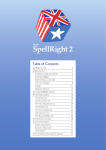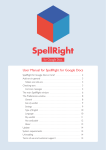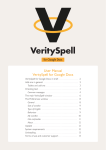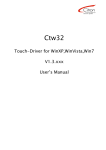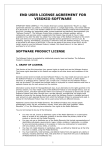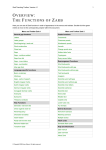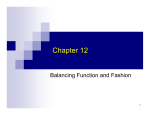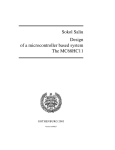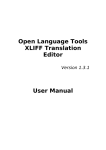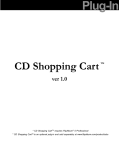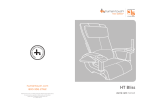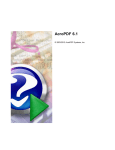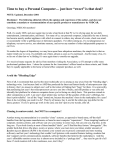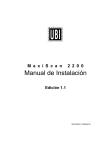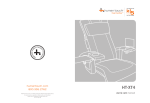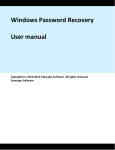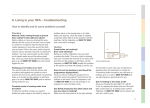Download Table of Contents
Transcript
Table of Contents VeritySpell in brief Getting started . . . . . . . . . . . . . . . . . . . . . . . . . . . . . 2 . . . . . . . . . . . . . . . . . . . . . . . . . . . . . . . . 2 Installation (single-user licence) . . . . . . . . . . . . . . . . 2 Running VeritySpell . . . . . . . . . . . . . . . . . . . . . . . . . . . 3 Spell-checking, an example Common messages Settings . . Keyboard shortcuts . . . . . . . . . . . . . . . . . . . 5 . . . . . . . . . . . . . . . . . . . . . . . . . . 8 . . . . . . . . . . . . . . . . . . . . . . . . . . . . . . . . . . . . . . . . . . . . . . . . . . . . . . . . . . . The main VeritySpell window . . 12 13 . . . . . . . . . . . . . . . . 14 . . . . . . . . . . . . . . . . . . . . . . . . 18 . . . . . . . . . . . . . . . . . . . . . . . . . . 18 The Settings window . . The General tab . . The My wordlist tab . . The Not confusable list tab . . . The Graphics tab The Text-to-Speech tab . . . The Supervisor tab . . The About VeritySpell tab . . . . . . . . . . . . . . . . . . . . . . . . . 22 . . . . . . . . . . . . . . . . 24 . . . . . . . . . . . . . . . . . . . . . . . . . . . 25 . . . . . . . . . . . . . . . . . . . 26 . . . . . . . . . . . . . . . . . . . . . . . . 27 The Dictionary window . . Technical information . . . . . . . . . . . . . . . . . . . 28 . . . . . . . . . . . . . . . . . . . . . 28 . . . . . . . . . . . . . . . . . . . . . . . . . System requirements . . Network configuration . . Uninstallation . . . . . . . . . . . . . . . . . . . . . . 31 31 . . . . . . . . . . . . . . . . . . . . . 31 . . . . . . . . . . . . . . . . . . . . . . . . . . . . . . 32 Terms of licence and customer support 1 . . . . . . . . 32 VeritySpell in brief VeritySpell is a program that corrects spelling mistakes in English. It is specially designed for people with reading and writing difficulties, like dyslexia. VeritySpell can correct serious spelling mistakes that other spellcheckers would not recognise, for example yoost (for used) and citon (for kitten). It also explains the difference between confusable words such as their, there and they’re. To help users choose the right word, VeritySpell presents suggestions with example sentences. It has a simple grammar checker which finds grammar mistakes such as The cats is hungry and suggests that you should write either The cats are hungry or The cat is hungry. There is also a dictionary to look up words in, and you can (usually) have words read out loud because VeritySpell supports most text-to-speech functions on the market. It is easy to control how VeritySpell will behave. All you need to do is to choose a wordlist of the right size for you and change your other personal settings as appropriate. VeritySpell can be used: • as an add-in with Microsoft Office; • as a stand-alone program, for example with OpenOffice and a few other wordprocessing suites or with the Clipboard. This User Manual tells you more about how VeritySpell works. First there is a section called Getting started where you will find out enough to start using the program, and then there are other sections with more detailed descriptions. If you want to know even more, the website of Oribi AB includes more information about VeritySpell as well as frequently asked questions (FAQs) about the program. Please have a look at www.oribi.se. Getting started Installation (single-user licence) 1. Start Microsoft Windows. 2. Insert the CD in the CD drive of your computer. The installation program should start automatically. 3. If it does not, double-click on the file called install.exe to start the installation program. 4. Follow the instructions on the screen until the installation is complete. 2 If you have a network licence and are going to install VeritySpell in a network, go to the Network configuration section at the end of this User Manual for further information. The first time you activate VeritySpell, it will ask for an activation key (at least if you have a licence for 1, 5, 10 or 25 users). Your activation key is on a sticker on the inside of the box that the VeritySpell CD came in. Running VeritySpell VeritySpell can check text in Microsoft Office, a number of other word-processing suites and the Clipboard. The document you want to check must be open. If you want to check text in the Clipboard, you must of course make sure that the text is there, read more under The Clipboard. When you activate VeritySpell, it starts spell-checking from the insertion point (the point in the text where the text cursor is). If the insertion point is at the end of the document, VeritySpell starts from the beginning. You can also select a part of the document for VeritySpell to check. If you activate VeritySpell before you have written anything, it will just say Spellcheck completed. Microsoft Office VeritySpell can check text in four Microsoft Office programs: Word, Excel, PowerPoint and Outlook. How you start VeritySpell from Microsoft Office depends on how new your Office version is. Microsoft Office 2007 or later If your version of Microsoft Office is 2007 or later, you go to the Oribi tab to start VeritySpell. 3 If you want to be able to start VeritySpell faster, you can add a VeritySpell icon to the Quick Access toolbar. This is how you do it: 1. Click the Customize Quick Access Toolbar button (the down arrow to the right of the toolbar). 2. Choose More Commands… 3. Choose the Oribi tab in the Choose commands from… box. 4. Click the Oribi VeritySpell icon. 5. Click the Add button and then OK. Microsoft Office 2003 or earlier To start VeritySpell you go to the Tools menu and select Oribi VeritySpell. Once you have started VeritySpell, you can activate it by using the Hot Key command, which is Win + X (depending on your version of Windows, you may need to use a different combination of keys). You can change the combination of keys in the Settings window. Other word-processing suites If you are using any of the word-processing suites OpenOffice, StarOffice or LibreOffice (from now on we will refer to all of these as OpenOffice), you can have VeritySpell check your text files and spreadsheets. This is how you do it: 1. Start VeritySpell from the desktop shortcut or the VeritySpell icon in the Start menu. 2. Open your OpenOffice file and double-click on the VeritySpell icon in the system tray. VeritySpell will now start correcting your OpenOffice document. Once you have started VeritySpell, you can activate it by using the Hot Key command, which is Win + X (depending on your version of Windows, you may need to use a different combination of keys). You can change the combination of keys in the Settings window. 4 The Clipboard You can also use VeritySpell to check text that you have placed in the Clipboard. This is how you do it: 1. Start VeritySpell from the desktop shortcut or the VeritySpell icon in the Start menu. 2. Right-click on the VeritySpell icon in the system tray. 3. Select Check clipboard. You can also use a Hot Key command to check text in the Clipboard. To do this, you first select the text you want to check and then copy it to the Clipboard by pressing Ctrl + C. To check the text which is now in the Clipboard, you press Win + C in Windows XP (if you have another version of Windows, you may need to use a different combination of keys). You can change the combination of keys in the Settings window. For more information about the Hot Key Clipboard, see the section called The Settings window below. When VeritySpell has finished checking the text, you typically paste it back into the document you copied it from using Ctrl + V. Spell-checking, an example Martin’s teacher has asked the class to write a story called My Pet. Martin has written his first draft and activates VeritySpell. VeritySpell stops at the highlighted word in this sentence (Martin doesn’t actually have a pet because his parents won’t allow it): I would love to have a citon. 5 VeritySpell does not know the word citon, so it gives one of its main messages, Unknown word (you can read more about those messages in the Common messages section below) and suggests the spelling kitten instead. Martin first selects the word kitten by clicking on it once with his mouse. Then the Speak button lights up, and Martin clicks it to hear what the word sounds like. It sounds about right. To make sure that this really is the word he wants, he would have liked to see it in an example sentence, but the Examples button is grey and the word itself is blue. That means VeritySpell has no example sentence with kitten in it. Instead he clicks the Show more icon a few times to see more suggestions. VeritySpell suggests first curtain, then certain and then cotton. Martin feels pretty sure those words are not at all what he wants. To check that the meaning of the word is what he thinks it is, Martin then clicks the Dictionary button at the bottom of the window (the word kitten is already in the Look up box because he clicked it above in the Suggestions window). The dictionary says young domestic cat. The pet he’d like definitely is a young cat, so this really must be the right word. To replace citon in his text with kitten, Martin now clicks the Replace button. VeritySpell then goes on spell-checking and stops at a word in Martin’s next sentence: It kneads love. 6 VeritySpell now gives the message Confusable words and lists three example sentences with words in them that all sound the same but are written differently: one for kneads and two for needs. The first one in the list, The baker kneads the dough, does not look right to Martin, so he goes on to the next one, He needs to leave early today. That sounds quite all right, but the last sentence, The patient needs medicine, makes him sure that the spelling should be need and not knead. He remembers that his teacher told him to double-click on the word he wanted instead of first selecting it and then clicking the Replace button, and he gives it a go. It works just the same: now his text says It needs love. The next stop VeritySpell makes is at this sentence: The kitten are cute. VeritySpell gives the message Grammar and suggests that instead of kitten are, Martin should write either kitten is or kittens are. Martin immediately decides that what he wants to say is kitten is, and so he double-clicks that. 7 Finally VeritySpell stops at this: You have to buy special pet food for it. VeritySpell gives the message One word? and suggests petfood. This one should be written as a single word, then. Martin sighs (but quietly, so his teacher won’t hear it) and double-clicks. Common messages Below is a list of the most common messages you will get from VeritySpell with explanations of their meaning. We recommend that you spend some time familiarising yourself with what the various messages mean. 1. Unknown word You get this message when you have written something that is not included in the wordlist you are using (to find out more about how your choice of wordlist affects the suggestions you get from VeritySpell, see Size of wordlist below). Here the user has written sositch: 8 For lunch, I had a sositch. VeritySpell presents one (or sometimes several, if they are all considered to be equally likely) suggestion in first place – here: sausage. It is often enough to have just one or two suggestions, but if you want to see more you just click Show more (the button with the broad blue arrow pointing downwards). Each click will reveal one more suggestion. What VeritySpell suggests depends on what wordlist you are using. In this case we are using the Standard list, and once we have clicked Show more until there are no more suggestions, this is what we see: 9 2. Confusable words You get this message when you have written a word that VeritySpell considers to be easily confusable with another. VeritySpell tells you to check that you have made the right choice. There are example sentences to illustrate the meanings of confusable words, like witch and which. VeritySpell has about 11,300 such example sentences. One example, with the Standard wordlist activated: VeritySpell stops at fillings to let you know that you should double-check: What she said really hurt my fillings. You probably should have written feelings here. To choose the right word you just double-click on it or first select it and then click Replace. In many cases VeritySpell is able to take account of the surrounding words when assessing whether you have made a mistake. This means that VeritySpell will make fewer unnecessary stops where you have actually used the correct spelling. Here is an example: I like to meet new people. VeritySpell will not stop at meet, which is correct here. Vegetarians don’t eat meet. Here, by contrast, VeritySpell will stop at meet and warn you about confusable words: 10 3. Grammar You get this message when VeritySpell thinks you have made a mistake which is not about spelling but about word endings, word order or sentence structure. What VeritySpell has reacted to is selected in the text, and the message box shows the correction it suggests you should make. Here is an example: The cats is hungry. This means that VeritySpell thinks you should replace cats is with either cats are or cat is. If you want to insert one of VeritySpell’s suggestions in your text, you either double-click that suggestion or first select it with your mouse and then click the Replace button. If you think what you have written is correct, you just click the Next button to continue the spellcheck without making any change to your text. 11 Settings There are a number of settings that you can change to adapt VeritySpell to your personal needs. You change them in the Settings window, which you can read more about in the section called The Settings window. There are several ways of opening that window. 1. You can open it from the VeritySpell main window while the program is checking a text. Just press the Settings button (with a cogwheel icon) shown at the bottom of the screenshot below. 2. You can also change them after first starting the program, even if you haven’t written anything. When you start VeritySpell, its main window opens with the Settings button at the bottom. 3. The third way is to right-click the VeritySpell icon in the system tray and then select Settings. VeritySpell can handle several users who may each have different settings for how they want the program to work. Each user’s personal settings and dictionaries are saved in that user’s library. The file with personal settings is called brukinst.ini 12 Keyboard shortcuts When VeritySpell is active, you can use the following keyboard shortcuts: Win + X Start a spellcheck (works only if you have started VeritySpell separately (from the Start menu) and the VeritySpell icon is shown in the system tray in the bottom right of the screen). This is called the Hot Key and you can change it to another combination of keys in the Settings window. Win + C Copy text to the Clipboard and start a spellcheck (works only if you have started VeritySpell separately (from the Start menu) and the VeritySpell icon is shown in the system tray in the bottom right of the screen). This is called the Hot Key Clipboard and you can change it to another combination of keys in the Settings window. Ctrl + I Open the Settings window (corresponds to a click on the Settings button). Alt + C Listen to a word. If the Speak icon is active, you can use this shortcut to have a word read out loud using a text-to-speech function (corresponds to a click on the Speak button). Up arrow Go one step up in VeritySpell’s list of suggestions or in the list of definitions in the dictionary. Down arrow Go one step down in VeritySpell’s list of suggestions or in the list of definitions in the dictionary. Right arrow Go to VeritySpell’s next stop in the text (corresponds to a click on the Next button). Double-clicking on a word has the same effect as first selecting it with your mouse and then clicking Replace. Whenever there is a single underlined letter in a word below a button or on a tab, instead of clicking with the mouse you can press the Alt key and that letter on the keyboard at the same time. 13 The main VeritySpell window This section explains the functions of the various buttons, etc., in the main VeritySpell window. We start from an example of how the main window may look when VeritySpell has stopped at a word during spell-checking. The user has written: I know witch one it is. Suggestions panel The (normally) white space in the middle of the window is called the Suggestions panel. This is where you get suggestions and messages from VeritySpell. Above and below it are a number of buttons and a text box. Replace To put one of VeritySpell’s suggestions in your text instead of what you first wrote, you select that suggestion and click the Replace button – or just double-click directly on that suggestion in the Suggestions panel. Show more In most cases, VeritySpell first suggests one or two words. To see more suggestions, click the Show more button. 14 Next If you want VeritySpell to go on checking until it finds something else (for example if you don’t want to replace the word you have written with any of VeritySpell’s suggestions), you click the Next button. Undo To undo your most recent change and go back to the previous word that VeritySpell stopped at, click the Undo button. If you just added a word using the Add button or marked a word as not confusable using the Not confusable button, you can’t undo that by pressing the Undo button. To do that you must go to the Settings window. Add If you have written a word which is new to VeritySpell and you want the program to learn that word, you click the Add button. (In the case of witch this is not possible because VeritySpell already knows that word. This is why the button is grey.) Not confusable If you never make a mistake about a word that VeritySpell thinks is easily confused with other words, you can press the Not confusable button. Then VeritySpell will no longer stop at that word. Doing so would not be advisable in the case shown above, because the writer has made a mistake. 15 Speak If you want to hear a word you see in VeritySpell spoken out loud, you select that word and then click the Speak button. Another way is to press Alt + C on the keyboard. If you click the Speak button or press Alt + C when you haven’t selected anything in the Suggestions panel, everything in the panel will be read out. You can only have text read out loud if you have a text-to-speech function on your computer and have selected that function in the Settings window (under the Text-to-Speech tab). You can read more about this in the section called The Settings window. Examples If you want to see a word in its natural context, you select that word and click the Examples button. VeritySpell does not have example sentences for all words. If it has one for a word, that word will be green in the Suggestions panel and the Examples button will be active (i.e. not grey). If there is no example, the word is blue and the button is grey. (If you want other colours, you can change them in the Settings window, under the Graphics tab.) When you click the Examples button, the Examples window opens. In the case of witch VeritySpell shows the example below. If you have a text-to-speech function installed on your computer and it is selected for use in the Settings tab, you can also have the example sentence read out loud by clicking the Speak button to the left. Clicking the OK button at the bottom closes the Examples window but does not change anything in your text. 16 Look up text box The Look up text box is where you write a word that you want to look up in VeritySpell’s dictionary. If you select a word in the Suggestions panel, that word automatically appears in the Look up box as well, making it easier for you to look it up if you want to. Dictionary VeritySpell has its own dictionary. You can use it to find definitions of words, words with similar meanings and other information. This is how you do it: • First you either select a word in the Suggestions panel or type it into the Look up text box. • Then you click the Dictionary button to open the Dictionary window. To find out more about the Dictionary window, see the section called The Dictionary window. Settings Clicking the Settings button opens the Settings window, where you can change your VeritySpell settings. Help If you click the Help button, the Help window opens. If you select one of the topics in the left-hand part of it, information about that topic is shown in the right-hand part. Close You click the Close button to shut down VeritySpell. 17 The Settings window The Settings window is where you change your VeritySpell settings. You open it by clicking the Settings button in the main VeritySpell window or by right-clicking the VeritySpell icon in the system tray and then selecting Settings. The Settings window is divided into seven tabs. To open a tab you just click on it. The General tab The General tab is where you make general settings for VeritySpell. Size of wordlist This is where you choose which of VeritySpell’s two wordlists you want to use: Standard (fairly small) or Advanced (big). Standard is the default. Standard The Standard list contains about 35,000 words. Typical Standard words are horse, considerate and vow. The intended users of the Standard list are adolescents and adults whose vocabulary ranges from small to average. When you install VeritySpell, the Standard list is the default choice. 18 Advanced The largest wordlist, Advanced, contains about 60,000 words in addition to those from the Standard list, meaning that the total is about 100,000. Words that are to be found only in the Advanced list are not very frequent. Examples of such words are ply, fowl and anthropomorphism. The performance of VeritySpell can sometimes differ depending on which wordlist you have chosen to work with. For example, the misspelling of scandelus (for scandalous) will give the following suggestions with the Standard and Advanced wordlist, respectively: Stop at confusable words Do you want VeritySpell to warn you of words that can easily be confused with each other? If you check this box, the program will stop, for example, whenever you have written witch and show you the words witch and which with explanations of what they mean. Please note that VeritySpell will then stop even if you have used the correct spelling. If you think VeritySpell stops too often at a certain word, you can click the Not confusable button during the spellcheck. In many cases, VeritySpell is able to take account of the surrounding words when assessing whether you have made a spelling mistake. This prevents it from stopping where you have not actually made a mistake. 19 Check spaces and punctuation Here you choose whether VeritySpell should react for errors in spaces and punctuation, e.g. if there is a space before a full stop (as in Hello, said Sam .) or if you have written both an interrogation mark and a full stop (as in What do you think?.). Perform basic grammar check Here you decide whether VeritySpell should react to a number of common grammar mistakes like The cats is hungry. We recommend that you check this box. Note that you may have to activate spell-checking twice if a grammar mistake includes a spelling mistake, because VeritySpell cannot correct all mistakes at the same time. In practice, you may run VeritySpell again when you have gone through your text, to see if it finds anything more. Check capitals when using Add button You can teach VeritySpell new words that are not included in its wordlist. To do this, you click the Add button. If the word you have told VeritySpell to learn begins with a capital letter, this may be because it always does (if it is a name like Megan or Auckland) or just because it is the first word in a sentence. This is useful for VeritySpell to know. If you check the Check capitals when using Add button box, then whenever you click the Add button VeritySpell will ask if the word you are teaching it should always begin with a capital. If that word is a name you should answer Yes and if it’s not you should answer No. Show example sentences If you have selected this, VeritySpell will show sentences to illustrate the use of confusable words. VeritySpell contains over 11,300 sentences, each giving an example of a different word usage. Even when this option is not selected, you can still get VeritySpell to show examples by clicking the Examples button. Show suggestions You can choose how many suggestions VeritySpell should show right away: one, two, three or all. The default is one suggestion – because we hope VeritySpell will usually give the right suggestion immediately. Then there is no point in forcing the user to read a lot of unnecessary text. Please note that even if you choose to see only one suggestion, VeritySpell will sometimes show more than one word. That is because VeritySpell sometimes thinks several suggestions are exactly as likely. 20 Language This is where you choose your working language: British or American English. British English is the default. If British English is selected, VeritySpell will stop at the American spelling color and suggest the British equivalent: colour. The opposite is true, of course, if you have selected American English. Compounds When two or more words have come together to form a new word, it is sometimes unclear how the new word should be written. For example, should you write dining table as two words with a space between them, dining-table with a hyphen or diningtable as one word? Dictionaries differ in their practices on this point. For VeritySpell we have chosen to follow the recommended standard of the Times of London, which in this case prefers two words. VeritySpell will therefore give dining table as the correct spelling here. In some cases VeritySpell considers several variants of the same compound as correct. -ise or -ize? Verbs like realise/realize are usually spelt -ise in British English even though -ize is also sometimes considered correct. For VeritySpell we have chosen -ise as the only correct British spelling. In American English, such verbs are always spelt -ize. Hot Key Here you can choose a different combination of keys for the Hot Key, which you use to start a spellcheck. The default is Win + X and there are a few other options to choose from. Hot Key Clipboard Here you can change the combination of keys for the Hot Key Clipboard, which you use to copy text to the clipboard and start a spellcheck. The default is Win + C and the other option is Win + S. 21 The My wordlist tab Under this tab you can edit your own wordlist. If a word has ended up there by mistake you can remove it by selecting it in the list and clicking the Delete button. To change the spelling of one of your own words, you select it and click the Edit button and then edit the word. You can also add words to your wordlist under this tab by clicking the Add button or the Add words from text document button (see below). 22 Add words from text document This button allows you to teach VeritySpell a lot of new words quickly, for example words that are specific to a subject area (technology, business, etc.). If you have a text file on your computer (the format must be *.txt), VeritySpell can find all the new words in that file and add them to the wordlist. This is a quick and easy way of adapting the wordlist to special purposes. This is how you do it: 1. If you have an Office document that you want to use, you can create a *.txt file from it. Select Save As and then choose Text Only, Plain Text or something similar under Save as type. Check that the file has been saved as a *.txt file (Text Document). 2. Click the Add words from text document button and select a *.txt file on your computer. Click Open. VeritySpell will check that file against the VeritySpell wordlist you are using and then show all of the new words from the file in a list. There will be a checkbox next to each new word. 3. Go through the list very carefully to ensure that no misspelt words are added. Uncheck any word that should not be added to the wordlist. 4. Click the Add selected words button. Clicking the Reset button unchecks all words and clicking the Select all words button checks all words. If you click the Speak button next to the list, VeritySpell reads out the selected word. 23 The Not confusable list tab If you don’t want VeritySpell to stop at certain words, you can enter them one by one under the Not confusable list tab. Click the Add button and write the word in the box. (This is an alternative to clicking on the Not confusable button in the main VeritySpell window when the word turns up during a spellcheck.) You can also change the spelling of a word you have added here (by clicking the Edit button) or remove a word from the Not confusable list (by clicking the Delete and reset button) if you have changed your mind and want VeritySpell to go back to warning you about it. 24 The Graphics tab By clicking on the Graphics tab you can change various things to do with what VeritySpell looks like on the screen: font sizes, fonts, font styles and colours, as well as text labels and icon sizes. If you want to change the size of the VeritySpell window, you just push or pull a corner (of the main window, not the Settings window) with your mouse pointer. The text size of the suggestions will change automatically to suit the new window size. Under the Graphics tab there is also a Reset button. Clicking this will reset all of your own choices to the default ones that the program was installed with. 25 The Text-to-Speech tab If there is a text-to-speech function installed on your computer, you can have VeritySpell’s suggestions and a few other things read out loud. Then VeritySpell must know what kind of text-to-speech function you want to use. You enter that information under the Text-to-Speech tab. There are two main types of text-to-speech programs: 1. Those where you select text and send it to the Clipboard to be read out loud. In the screenshot above we have indicated that we are using such a program. If you want to use text-to-speech via the Clipboard, you must check the Use Text-to-Speech via clipboard box. Then all text-to-speech settings are made in the text-to-speech program and you cannot control them from VeritySpell. 2. Those that are SAPI compatible. The settings for a SAPI compatible text-to-speech program can be changed from VeritySpell. If you have this type of program, check the Use SAPI Text-to-Speech box and choose the voice to be used. Please note that some text-to-speech functions require that you start them separately. 26 The Supervisor tab Under this tab, a supervisor (for example a teacher) can control certain functions that will apply to all users of VeritySpell. This is a way to make VeritySpell as useful as possible to each individual user. The supervisor can protect his or her settings by means of a password (using the Change supervisor’s password button). The supervisor can also do a few other things in the Supervisor window. To open it you click the Supervisor’s wordlist button. This window has two tabs: 27 • Under the Supervisor’s wordlist tab, the supervisor can add words that are to be included in the wordlists of all users, for example the names of schoolmates, teachers and local street names. This wordlist works in the same way as the userspecific wordlist (see the section on the My wordlist tab above). • Under the Supervisor’s Not confusable list tab, the supervisor can add confusable words that VeritySpell should never stop at for any user. This list works in the same way as the user-specific Not confusable list (see the section on the Not confusable list tab above). The About VeritySpell tab Under this tab you will find general information about VeritySpell, for example the version number. The Dictionary window About the dictionary VeritySpell has a large English dictionary. This dictionary contains definitions and examples of how a word is used as well as synonyms (words with similar meanings, such as happy and joyful), antonyms (words with opposite meanings, such as good and bad) and other related words. The dictionary is based on WordWeb and covers over 150,000 English words. There is a special tool that tries to guess what you mean if you have misspelt a word. To use the dictionary, you type a word in the Look up text box at the bottom of the main VeritySpell window (if you have selected a word in the Suggestions panel, it will automatically appear in the Look up box as well) and press the Dictionary button (shown above) next to that box. Then the Dictionary window opens. 28 In the example below, the user has written essentil in the Look up box. VeritySpell assumes that the user really wants to look up essential and shows the dictionary entry for that word. The Definitions panel and the Related words panel The (normally) white space in the middle of the window (shown above) is divided into two parts. The left-hand part is called the Definitions panel. This is where you get definitions of meanings from the VeritySpell dictionary. If there are several definitions for a word, you select one of them by clicking on its number or using the up and down arrow keys on the keyboard. This will change the information about related words shown in the Related words panel on the right. The right-hand part is called the Related words panel. Here you get links to synonyms, antonyms, etc. You can look up any word that appears in either of these panels (except the headings in the Related words panel) in the dictionary by double-clicking it. To move up or down within either panel you use the up and down arrow keys. Above these two panels are a number of text boxes and buttons. 29 The Look up text box The Look up text box in the top left corner of the Dictionary window shows the word you just looked up. If you want to make a new search, you just type a new word in the Look up box. To look up a word again you can use the drop-down menu next to the box to get a list of your recent searches. The Look up button You click this button to look up the word in the Look up text box. The results will be shown in the Definitions and Related words panels. The Back and Forward buttons You click these buttons to go through your recent searches. The Paste button To paste a word from the dictionary into the document or text you are spell-checking, select that word with the mouse and then click the Paste button. The Speak button To hear the contents of the dictionary read out loud, select the text you want to hear with the mouse and then click the Speak button. The Hits drop-down menu and the Next hit button If you made a spelling mistake with the word you looked up, the Hits drop-down menu just below the Look up box lists the best results of your search (if you didn’t make a spelling mistake, there will be just one word in the list). You can select a word in the Hits list to look it up or see the hits (with definitions) one at a time by clicking the Next hit button next to the Hits menu repeatedly. 30 Technical information System requirements For VeritySpell to work, your computer must meet the following requirements: • Pentium processor or better. • CD-ROM drive. • At least 8 MB free RAM. • At least 40 MB free hard-disk space. VeritySpell works under Windows 2000/XP/Vista/Windows 7 with Microsoft Office 2000 or later (this applies to Word, Excel, PowerPoint and Outlook), OpenOffice, StarOffice, LibreOffice and the Clipboard environment. However, VeritySpell does not at present (October 2011) work under the 64-bit version of Microsoft Office 2010. Network configuration For full network support you need a network licence (also referred to as a school or local-authority licence). We recommend that you install the program from a client machine. When you are running the installation program you may choose Network installation by selecting a check box. During the installation process you may indicate where the main VeritySpell folder will be located. All users must have read access to that location. When the installation is complete, there will be not only a folder with files used by VeritySpell but also a special installation program called InstallClient.exe which can be used to install VeritySpell on other workstations in the network. Installing VeritySpell at a workplace There are certain files that must be on the local PC. When you run InstallClient those files will be copied from the main VeritySpell folder to the local PC. Workplace installation must be carried out at all computers that are going to use VeritySpell. Personal and common data are saved according to the Windows configuration and in accordance with Microsoft’s recommendations. VeritySpell reads in the Windows registry where data can be saved. The registry key for personal data is: HKEY_CURRENT_USER/Software\Microsoft\Windows\ CurrentVersion\Explorer\Shell Folders/AppData and that for common data is: HKEY_LOCAL_MACHINE/Software\Microsoft\Windows\CurrentVersion\ Explorer\Shell Folders/Common AppData 31 InstallClient copies certain files from the main VeritySpell folder to the hard disk of the local computer. • sr32rx.dll is copied to the Windows system folder, which may be C:\Windows or C:\WinNT\System32 depending on the version of Windows. • TextSpeaker.ocx is a module enabling VeritySpell to use text-to-speech. It is located in the folder C:\Program\SIHDev\Textspeaker • ospVeritySpellAddIn.dll is used by Microsoft Office. InstallClient also creates a desktop icon and an icon making it possible to start VeritySpell from Start/All Programs/VeritySpell. Variant network installation A variant way of making a network installation is to make a complete installation of the program. You ‘push out’ the installation program from a server. To install the programs ‘silently’, i.e. with no dialogue windows opening, you can use parameters for the installation programs. To install you write: Install.exe /sp- /norestart /verysilent and to uninstall you write: C:\Program\VeritySpell\UNWISE.EXE /S C:\Program\VeritySpell\ INSTALL.LOG Uninstallation 1. Open Control Panel/Programs/Programs and Features. For Windows XP, open Control Panel/Add or Remove Programs. 2. Click VeritySpell. 3. Click Uninstall. 4. Choose type of uninstallation: Automatic (the entire program will be removed) or Custom (the files you select will be removed). Terms of licence and customer support Oribi VeritySpell is a registered trademark and the program is protected under the Swedish Copyright Act and corresponding international legislation. It is a criminal offence to make copies of the program for reasons other than making a personal backup copy. Support for VeritySpell is provided by our distributors or by ourselves at Oribi AB in Lund, Sweden. You can call us at (46 46) 32 30 12 or e-mail us at [email protected]. 32 Oribi VeritySpell IPR, programming and handbook: © Oribi AB, 2005–2011. Oribi AB, Bredgatan 2, 222 21 Lund, Sweden tel +46 46-32 30 12, fax +46 46-32 30 11 [email protected], www.oribi.se 33

































